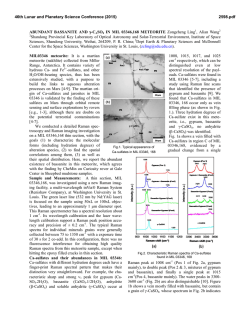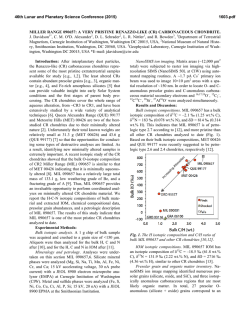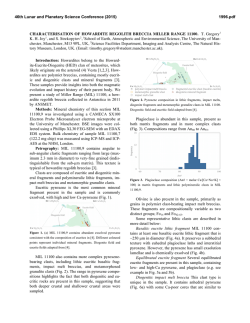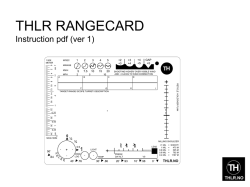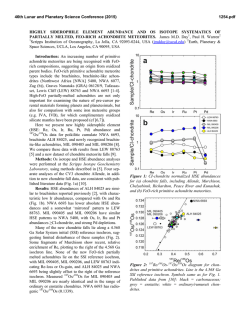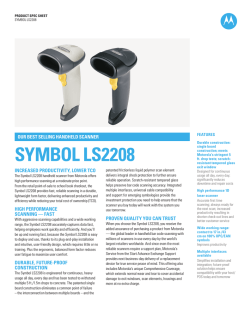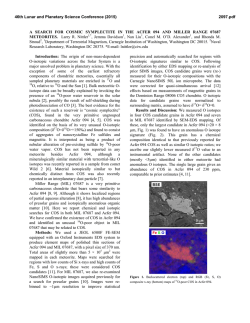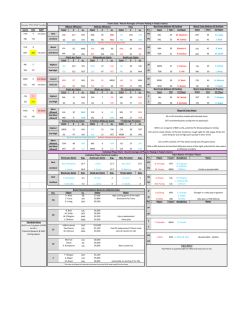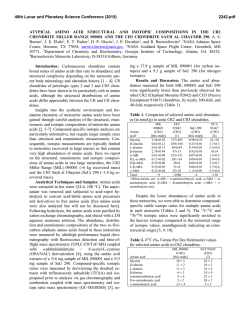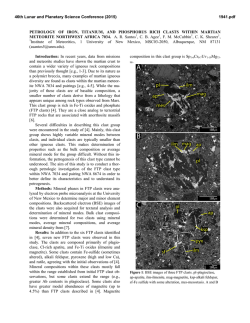
Geochemical Analysis and Possible Launch Sites of Lunar Breccias
46th Lunar and Planetary Science Conference (2015) 1585.pdf GEOCHEMICAL ANALYSIS AND POSSIBLE LAUNCH SITES OF LUNAR BRECCIAS MILLER RANGE 090036 AND MILLER RANGE 090070. A. Calzada-Diaz1, K. H. Joy2, I. A. Crawford1, J. Spratt3 and S. Strekopytov3, 1 Department of Earth and Planetary Sciences, Birkbeck College, WC1E 7HX London, UK. 2 School of Earth, Atmospheric and Environmental Sciences, University of Manchester, M13 9PL, UK. 3 Sciences Facility Department, Natural History Museum London, SW7 5BD, UK. Introduction: Lunar meteorites, which were ejected from the surface as result of impact events, are an important source of lunar material in addition to the Apollo and Luna samples. Here we report the bulk element composition, mineral chemistry analysis and petrography of the Miller Range (MIL) 090036 and 090070 lunar meteorites, found during the 2009-2010 ANSMET field season in Antactica [1]. MIL 090036 and 090070 are both feldspathic regolith breccias consisting of mineral fragments and lithic clasts in a glassy matrix [2,3,4,5]. Differences in mafic minerals and KREEPy components indicate that these meteorites are not paired [6]. Analytical methods: We were allocated two chips of MIL 090036,34 and MIL 090070,35 (200 mg each) and two polished thick sections mounted in epoxy resin blocks. 150 mg of each chip were powdered and bulk major, minor and trace element chemistries were determined using a inductively coupled plasma spectrometer: ICP-AES was used for major elements and ICPMS for trace elements at the Natural History Museum (NHM), London. Back scattered images (BSE) and mineral chemistries were obtained using a Cameca SX100 electron microprobe at the NHM (20 keV accelerating voltage, 20nA beam current and 10-30 s count time). Element maps were collected using a Zeiss EVO EDX SEM and were processed using GIMP raster graphics editor to create false-colour element maps. Results: Bulk rock chemistry: The bulk rock major elements compositions are shown in Table 1. MIL 090070 is slightly more feldspathic (30.7 wt% Al2O3 3.4 wt% FeO) than MIL 090036 (26.7 wt% Al2O3, 5.3 wt% FeO). MIL 090036 is more magnesian (Mg# 67) than MIL 090070 (Mg# 61). MIL 090036 has an enhanced KREEP component as shown by its higher Th concentration (1.9 ppm), compared with MIL090070 (0.4 ppm Th). Mineral chemistry: Plagioclase composition in MIL 090036 ranges from An88-97 and in MIL 090070 from An93-97 Pyroxene grains show a large range of variability in both samples (Wo0-41 En35-70 Fs9-56 in MIL 090036 and Wo3-43 En35-77 Fs18-45 in MIL 090070). Olivine compositions are within a narrow range in borh samples (Fo61-68 in MIL 090036 and Fo59-63 in MIL 090070). Petrography: Regolith breccia MIL 090036 is characterized by lithic clasts up to 2 mm (i.e. anortho- site, gabbro, troctolite, regolith breccia and impact melt) and mineral fragments (i.e. plagioclase, pyroxene, olivine and ilmenite). Other minerals present in the sample in minor quantities are chromite, troilite, quartz and Fe-Ni metal (figures 1a and 2a). Element (wt.%) SiO2 TiO2 Al2O3 FeO MnO MgO CaO Na2O K2O Total Th (ppm) Mg♯ MIL 090036 ,34 46.24 0.48 26.72 5.27 0.07 5.92 15.45 0.57 0.08 100.8 1.89 66.7 SD 0.12 0.002 0.07 0.01 0.07 0.04 0.03 0.004 0.001 0.002 MIL 090070 ,35 45.16 0.16 30.72 3.39 0.05 2.98 17.45 0.37 0.03 100.3 0.44 SD 0.19 0.001 0.16 0.01 0.0002 0.02 0.04 0.002 0.0004 0.004 61.1 Table 1 Bulk chemistry of MIL090036, 34 and MIL090070, 35 measured using ICP-AES at NHM. Th measurements were obtained using ICP-MS. MIL 090070 is a regolith breccia, consisting of mineral fragments in a glassy matrix. Mineral fragments are predominantly plagioclase with minor phases of olivines and pyroxenes (figures 1b and 2b). Launch site: We have attempted to constrain the source regions of MIL 090036 and MIL 090070 utilizing geochemical data from the Lunar Prospector gamma-ray spectrometer. This instrument spatially resolved the abundance of major rock-forming elements (O, Si, Ti, Al, Fe, Mg, Ca) as well as radioactive incompatible elements (U, Th, and K) within the upper few tens of centimeters of the surface and has produced global abundance maps of the composition of the lunar regolith. We have used the software described in [7] and the FeO, TiO2 and Th measured compositions of the samples (Table 1) to investigate their the possible launch localities. Although MIL 090036 appears to have some similarities with Apollo 16 samples, its lower content in aluminium and the differences on modal abundances in 46th Lunar and Planetary Science Conference (2015) pyroxenes and feldspar suggest that this sample have been originated from an area outside of the regions sampled by Apollo and Luna missions [4]. Its Th content may indicate an origin not far from the Procellarum KREEP Terrain (PKT). According to our results this sample probably derives from an area in the border between the PKT and the surrounding highlands. MIL 090070 is highly feldspathic and it does not contain any mare basalt clasts or evolved (i.e., KREEPrich) clast components. Our results suggest areas outside the PKT and far from near side maria, possibly on the far side of the Moon, as a possible launch origin. 1585.pdf References: [1] Righter K. (2010) Ant. Met. News Lett. 33(2). [2] Liu Y. et al. (2011) XLII LPSC, Abstract #1999 [4] Shirai N. et al. (2012) XLIII LPSC, Abstract #2003 [5] Xie L. et al. (2014) Advances in Polar Science, 25(1), 17-25. [6] Zeigler R. et al. (2012) XLIII LPSC, Abstract #2377. [7] Calzada-Diaz A. et al. (2015) Meteoritics & Planet. Sci., (in press). Acknowledgements: We would like to thank the Johnson Space Center meteorite curation facility for providing the samples. Also we would like to thank Dr. Anton Kearsley from The Natural History Museum, London, for his help and support during the sample analysis. 7 mm 7 mm 5 mm Figure 1 Backscattered electron images of MIL 090036,34 (A) and MIL 090070,35 (B). Darker grey phases are plagioclases, medium grey phases are pyroxene and olivine. Brighter phases are mainly ilmenite. 5 mm Figure 2 Element maps of MIL 090036,34 (A) and MIL 090070,35 (B). The maps have been coloured Siblue, Al-white, Ca-yellow, Mg-green, Fe-red, Ti-pink and K-cyan to show qualitative element distribution and abundance
© Copyright 2026

